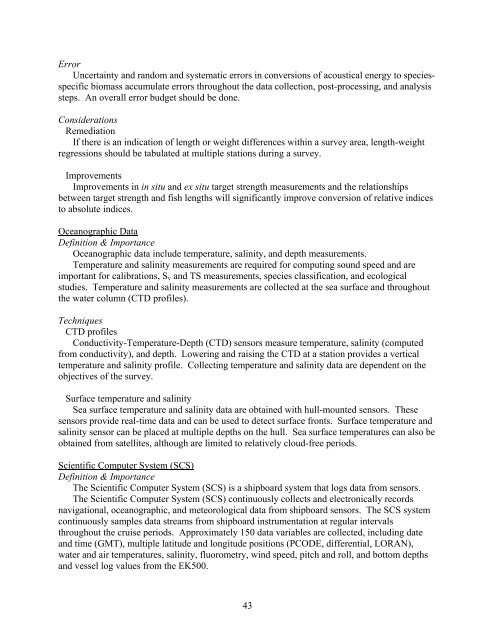NOAA Protocols for Fisheries Acoustics Surveys and Related ...
NOAA Protocols for Fisheries Acoustics Surveys and Related ...
NOAA Protocols for Fisheries Acoustics Surveys and Related ...
You also want an ePaper? Increase the reach of your titles
YUMPU automatically turns print PDFs into web optimized ePapers that Google loves.
Error<br />
Uncertainty <strong>and</strong> r<strong>and</strong>om <strong>and</strong> systematic errors in conversions of acoustical energy to speciesspecific<br />
biomass accumulate errors throughout the data collection, post-processing, <strong>and</strong> analysis<br />
steps. An overall error budget should be done.<br />
Considerations<br />
Remediation<br />
If there is an indication of length or weight differences within a survey area, length-weight<br />
regressions should be tabulated at multiple stations during a survey.<br />
Improvements<br />
Improvements in in situ <strong>and</strong> ex situ target strength measurements <strong>and</strong> the relationships<br />
between target strength <strong>and</strong> fish lengths will significantly improve conversion of relative indices<br />
to absolute indices.<br />
Oceanographic Data<br />
Definition & Importance<br />
Oceanographic data include temperature, salinity, <strong>and</strong> depth measurements.<br />
Temperature <strong>and</strong> salinity measurements are required <strong>for</strong> computing sound speed <strong>and</strong> are<br />
important <strong>for</strong> calibrations, S v <strong>and</strong> TS measurements, species classification, <strong>and</strong> ecological<br />
studies. Temperature <strong>and</strong> salinity measurements are collected at the sea surface <strong>and</strong> throughout<br />
the water column (CTD profiles).<br />
Techniques<br />
CTD profiles<br />
Conductivity-Temperature-Depth (CTD) sensors measure temperature, salinity (computed<br />
from conductivity), <strong>and</strong> depth. Lowering <strong>and</strong> raising the CTD at a station provides a vertical<br />
temperature <strong>and</strong> salinity profile. Collecting temperature <strong>and</strong> salinity data are dependent on the<br />
objectives of the survey.<br />
Surface temperature <strong>and</strong> salinity<br />
Sea surface temperature <strong>and</strong> salinity data are obtained with hull-mounted sensors. These<br />
sensors provide real-time data <strong>and</strong> can be used to detect surface fronts. Surface temperature <strong>and</strong><br />
salinity sensor can be placed at multiple depths on the hull. Sea surface temperatures can also be<br />
obtained from satellites, although are limited to relatively cloud-free periods.<br />
Scientific Computer System (SCS)<br />
Definition & Importance<br />
The Scientific Computer System (SCS) is a shipboard system that logs data from sensors.<br />
The Scientific Computer System (SCS) continuously collects <strong>and</strong> electronically records<br />
navigational, oceanographic, <strong>and</strong> meteorological data from shipboard sensors. The SCS system<br />
continuously samples data streams from shipboard instrumentation at regular intervals<br />
throughout the cruise periods. Approximately 150 data variables are collected, including date<br />
<strong>and</strong> time (GMT), multiple latitude <strong>and</strong> longitude positions (PCODE, differential, LORAN),<br />
water <strong>and</strong> air temperatures, salinity, fluorometry, wind speed, pitch <strong>and</strong> roll, <strong>and</strong> bottom depths<br />
<strong>and</strong> vessel log values from the EK500.<br />
43
















